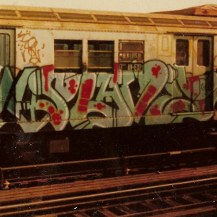The Elite in the Arts | Visual Arts
Street Art - The Art of the Streets?

In the 1970s, PHASE 2 and other young artists in New York City’s Bronx neighborhood spray tags, words, and images on buildings and subway cars. Many pieces use the bubble-style, which forms letters into big, bubbly shapes. Most artists have local roots in the African-American and Caribbean communities. For them, creating graffiti and applying it to the built environment and transportation infrastructure is a way of claiming their right to use public space. Pieces sprayed on subway cars travel through the entire city of New York.

1990s: Street art continues to occupy the streets. Graffiti artists go on writing and tagging in public space, preferably incognito after dark. Cities like Philadelphia support mural arts programs. They provide space and financial support to young artists who create murals on walls of buildings across the city. The creation of murals beautifies urban space. It also provides a creative outlet for youngsters from inner city neighborhoods. Peace Wall by Jane Golden and Peter Pagast (created in 1997) is a beautiful example.
2000s: Works created by Jean Michael Basquiat sell for top dollar on the international art market. Museums worldwide own his paintings. The Smithsonian National Museum of American Art in Washington, D.C. is just one example. At the same time, street art retains its original character as art created by artists in the streets and for the streets, much of it in an effort to draw attention and/or provoke. Artists continue to write graffiti and paint murals. They also use seed bombings and yarn bombings to claim space and bring color to urban environments. Street art continues to express the voice of an urban populace and to resist elite appropriations.
To the Overview